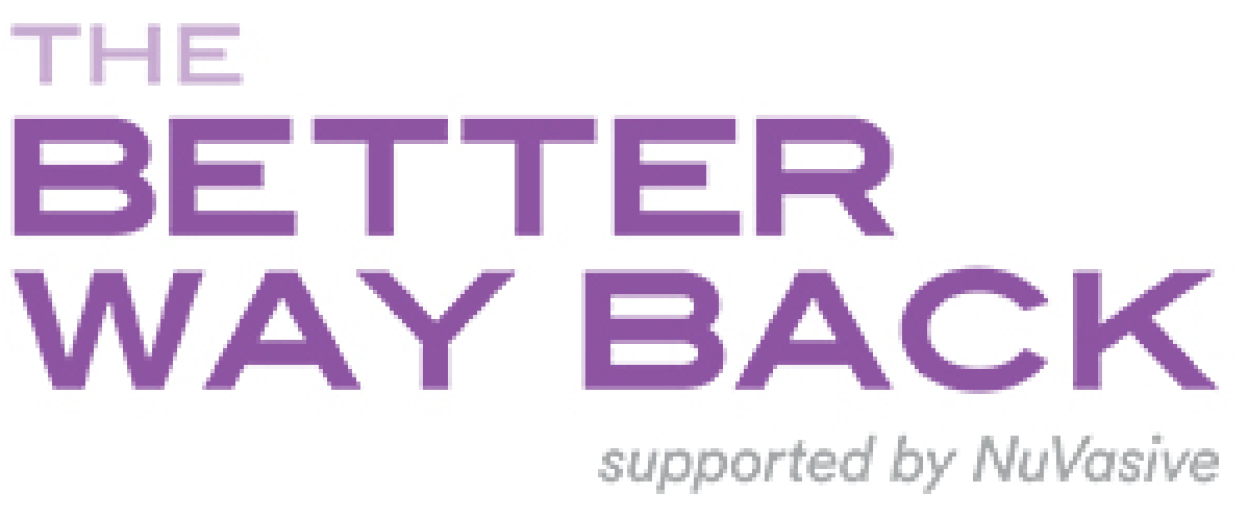This is the fifth in a series of guest posts by Jim Spell, The Better Way Back® Patient Ambassador. Check out part 1, part 2, part 3,
and part 4.
My name is Jim Spell. I recently had a full lumbar fusion. I am now the proud owner of 18 screws and two rods totaling more than two feet. My doctor compares it, with fondness and pride, to the Golden Gate Bridge. While I probably wouldn’t have found this metaphor as last year, my sense of humor is returning, along with my overall health.
Physical therapy
As soon as you awaken after surgery, movement begins. Eventually that movement is going to be vertical and then movement becomes walking. As you grow in strength and confidence, walking becomes exercise as you add stretching and familiar actions to your growing list of things you do—things like getting out of bed again, driving a car, reaching for the salt, and the like. The success of your surgery is measured by such movements and each one seems to have a “healing” aura about it. It is like the positive feeling you get after real exercise, such as skiing or running or swimming—that clean feeling that is somehow attractive in its memory. Deep down inside, you know these “new” movements are beneficial. But like everything else after surgery, the evidence is sparse in the beginning, to say the least.
But just as singular movement is not exercise, exercise is not necessarily “physical therapy” (PT). That doesn’t mean they are not related, but it is imperative to your overall success in recovery that you understand the difference and apply what you learn about each one to your overall “recovery program.”
Physical therapy is a technical element of recovery. It is the educated approach to gaining strength and proper balance during movement. Physical therapy is the intelligent approach to pain-free movement. Unlike exercise, PT is focused on one correct movement at a time, concerned with proper mechanics rather than a combination of movements resulting in an exercise, like throwing or kicking a ball. That comes later in your therapy/recovery program.
PT needs to be safe while being progressive. Much of PT is finding the difficulties in your movements as a result of the surgery. This could be the strength of one particular muscle or a loss of balance in one particular position. Whatever the challenge and subsequent solution, it must fit your recovery timeline and should never feel like you are doing too much or too little at any one time.
When you are ready and you have your surgeon’s approval, PT is not only a step up from basic exercise, it immediately focuses on your specific weaknesses and overall lack of balance. Yes, you will have to push yourself and there will be times your “discomfort” level will increase, but at no time should you feel like you are going backwards. That being said, you will have what can be called “mistake moments”—times when you go a little too far and you have to recover to get back to where you were in order to move forward again. It happens occasionally and is to be expected. Document and discuss exactly what happened, understand it, avoid it, and certainly give yourself permission to take a day off. Those days are filled with old movies and Ibuprofen.
It is important to note another very important benefit of PT. A good therapist can transition your careful, limited, and sometimes anxious movements into ones that are confident and strong. Being told during recovery the indisputable advice that you should not to bend, lift, or twist eventually puts a shroud of paranoid compliance on your movements. Going from a dutiful patient to a confident person in recovery can take some guidance. It is imperative for success that you take it one therapy session at a time, working toward a real-life goal, whether it is skiing or biking, hiking to your favorite fishing spot, or simply playing with the kids again. You accomplish your goals by listening patiently to your body and your physical therapist. In time, physical therapy will restore your movement, strength, and balance—and you will get back into your life.
Adding physical therapy to your recovery is simply applying what we know about how the body should move in optimal fashion for a strong, flexible, and pain-free life. A physical therapist is responsible for getting you there by applying specific movements for increased control of your body. Add to this massage, cold, heat, and possibly other techniques, and you have a physical therapy program designed just for you.
Always remember, it is your recovery, your program, and your body. Ultimately, you must determine what is appropriate exercise and therapy and what is not. There are definite ways to maximize the effectiveness of physical therapy and get the most out of your time with a therapist and that will be in Part 6 of this series…
13-NUVA-615
